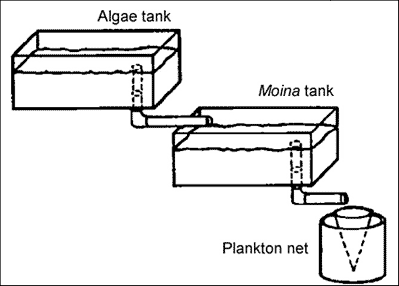

 |
||||||||||||
 |
||||||||||||
| Culture Techniques of Moina: The Ideal Daphnia for Feeding Freshwater Fish Fry | ||||||
| Page 2 of 6 | Pages: 1 . 2 . 3 . 4 . 5 . 6 | |||||
Food Requirements Moina feed on various groups of bacteria, yeast, phytoplankton and detritus (decaying organic matter). Bacterial and fungal cells rank high in food value. Populations of Moina grow most rapidly in the presence of adequate amounts of bacterial and yeast cells as well as phytoplankton. Moina are one of the few zooplankton which can utilize the blue-green algae Microcystis aeruginosa. Both plant and animal detritus may provide energy for the growth and reproduction of Moina. The food value of detritus depends on its origin and diminishes with the age of the detritus. Life Cycles of Moina The reproductive cycle of Moina has both a sexual and asexual phase. Normally, the population consists of all females that are reproducing asexually. Under optimum conditions, Moina reproduce at only 47 days of age, with a brood size of 422 per female. Broods are produced every 1.52.0 days, with most females producing 26 broods during their lifetime. Under adverse environmental conditions, males are produced and sexual reproduction occurs resulting in resting eggs (ephippia), similar to brine shrimp eggs. The stimuli for the switch from asexual to sexual reproduction in populations of Moina is an abrupt reduction in the food supply, resulting in an increase in resting egg production. However, it is advantageous to keep the population well fed and in the asexual mode of reproduction, since fewer progeny are produced with resting eggs. High population densities of Daphnia can result in a dramatic decrease in reproduction, but this is apparently not the case with Moina. The egg output of Daphnia magna drops sharply at a density as low as 95115 mature individuals per gallon (2530/L). The maximum sustained density in cultures of Daphnia reported is 1,900 individuals per gallon (500/L). Moina cultures, however, routinely reach densities of 19,000 individuals per gallon (5,000/L) and are, therefore, better adapted for intensive culture. A comparison of the production of Daphnia magna and Moina macrocopa cultures fertilized with yeast and ammonium nitrate, showed that the average daily yield of Moina (1.421.47 ounces/100 gallons; 106110 g/m3) is three to four times the daily production of Daphnia (0.330.53 ounces/100 gallons; 2540 g/m3). The daily yield of Moina cultures fed phytoplankton cultured on organic fertilizer have been reported to exceed 5 ounces/100 gallons (375 g/m3). Nutritional Value of Moina The nutritional content of Moina varies considerably depending on their age and the type of food they are receiving. Although variable, the protein content of Moina usually averages 50% of the dry weight. Adults normally have a higher fat content than juveniles. The total amount of fat per dry weight is 2027% for adult females and 46% for juveniles. Procedure for Moina Culture The batch culture method of producing Moina uses a continuous series of cultures. Briefly, a new culture is started daily in a separate container using the procedures outlined below. When all the fungal, bacterial, and algal cells are consumed, usually about 510 days after inoculation, the Moina are completely harvested, and the culture is restarted. This method is particularly applicable when a specific quantity of Moina is needed each day because daily production is much more controlled. Batch culture is also useful for maintaining pure cultures because there is less chance of the cultures becoming contaminated with competitors (e.g., protozoans, rotifers, copepods) or predators of fish larvae or fry (e.g., Hydra, back-swimmers, diving beetles, dragonfly larvae). Semi-continuous cultures can be maintained for two months or more by daily partial harvests of Moina, water changes and regular feeding, keeping the population in a state of rapid growth. Eventually, the Moina cultures will fail to respond to additional fertilization. When it is evident that they are not reproducing well, the Moina should be completely harvested and a new culture started. Moina can be produced either in combination with their food or as separate cultures. Combined culture is the simplest, but production from separate cultures has been reported to be approximately higher. For separate culture, the phytoplankton tank is positioned so that it can be drained into the Moina culture tank ( Figure 2 ). Production from separate cultures has the disadvantage of requiring additional space for the cultivation of phytoplankton. However, there are advantages of separate culture of Moina and phytoplankton. The advantanges include less chance of contamination, a greater degree of control, and more consistent yield. Note: Regardless of the culture method, always maintain several Moina cultures to ensure a supply in case of a die-off. 
Figure 2: Tank arrangement for the separate culture of Moina and its food. more... |
 |
|||||
| About Us :: Message Board :: Chat | |||||
| Library :: Photo Gallery :: Links & Resources :: Breeders & Sponsors :: Merchandise | |||||
| Website designed by: EthanCote.com | © 2001-2004, SimplyDiscus.com. All Rights Reserved. | ||||